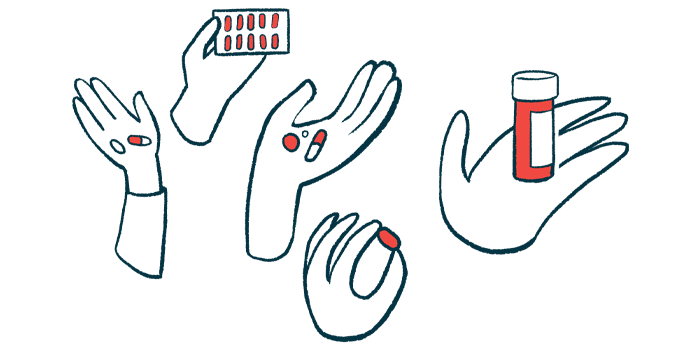Tacrolimus Safe and Effective as Own Immunotherapy for MG, Study Finds
Written by |

Tacrolimus is effective and safe as a single-agent immunotherapy for people with myasthenia gravis (MG), and its use led to minimal manifestation status in a majority of patients treated for one year in China, a study reported.
Favorable responses were particularly evident in younger patients (up to age 40), those with milder disease, and those with low MG-related autoantibodies levels, its researchers noted.
The study, “Tacrolimus as Single-Agent Immunotherapy and Minimal Manifestation Status in Nonthymoma Myasthenia Gravis,” was published in the Journal of Immunology Research.
MG is an autoimmune disease, caused by the immune system wrongly attacking proteins involved in neuromuscular junctions. An initial symptom is typically weakness in eye musculature (ocular MG), but it can be followed by muscle weakness elsewhere (generalized MG).
Corticosteroids are commonly used to suppress immune attacks and are generally considered a first-line therapy for MG. However, symptoms worsen in some patients after starting on this therapy, and long-term corticosteroid use is associated with complications ranging from weight gain to glaucoma and diabetes.
“Therefore, it is of great clinical value to explore new immunotherapy regimens for MG,” the researchers wrote.
Tacrolimus is an immunosuppressant that works by blocking the activation of T-cells — a specific type of white blood cell involved in the immune response. Initially used to prevent organ rejection in transplant patients, tacrolimus has been adopted for use in people with autoimmune diseases. It is available under brand names that include Prograf.
With MG, tacrolimus is mainly a second-line immunosuppressant and steroid-sparing agent. Few studies have investigated tacrolimus’ potential, as a single-agent immunotherapy, in achieving minimal manifestations status (MMS) — defined as no signs of functional limitations due to MG, although patients can have some degree of muscle weakness.
Researchers in Hunan evaluated whether tacrolimus alone could help these patients achieve MMS.
Medical records on 75 MG patients without thymoma — a tumor in the thymus that can be associated with MG — who started with tacrolimus as a single therapy at Xiangya Hospital from July 2017 to June 2020 were analyzed. Their average age was 41.6, most were female (61.3%), and the average time from disease onset to tacrolimus’ initiation was 50.14 months (just over four years).
Patients’ average quantitative myasthenia gravis score (QMG) — a scale used to quantify disease severity in MG — prior to treatment was 10.17 points. QMG scores range from zero to 39; lower scores indicate less severe disease. The Myasthenia Gravis Foundation of America (MGFA) classification, another system to classify MG disease severity, was also used.
A majority of patients (77.3%) had antibodies against acetylcholine receptors.
All had one month of follow-up data; at 12 months, follow-up records were available for 39 patients.
Overall, results showed that tacrolimus was safe, with no serious adverse reactions reported. Among these 75 patients, eight had adverse reactions, with most side effects alleviated through dose adjustment and symptom treatment.
The most common side effects were metabolic issues and gastrointestinal reactions, including elevated blood sugar, nausea, and higher levels of uric acid in urine. Two patients switched to other treatment regimens due to adverse reactions.
Changes in MGFA scores post-treatment showed improvements in 25.3% of 75 patients at one month, in 40.3% of 62 patients at three months, in 28.6% of 49 patients at six months, and in 12.8% of 39 patients after 12 months.
These results indicate that tacrolimus “has a rapid onset,” the researchers wrote.
Using minimal manifestations status or better as the treatment’s goal, researchers found that 6.7% (five of 75 patients) achieved MMS at one month of treatment, 19.3% (12 of 62) at three months, 44.9% (22 of 49) at six months, and 69.2% (27 of 39) at one year. Eight patients changed treatments or added a corticosteroid due to limited benefits.
“These results suggest that tacrolimus is effective and safe as single-agent immunotherapy for MG and can contribute to the realization of MMS in patients,” the researchers wrote.
An analysis was done to determine the probability of patients achieving MMS or better while on tacrolimus for each time point. Results showed a rise in probability in each respective patient group: 6.7% at one month, 18.1% at three months, 40.3% at six months, and 57.8% at 12 months.
Further analysis showed that “age, QMG score, and AChR-Ab titer [acetylcholine receptor antibody levels] were factors that affected patients to achieve MMS, regardless of gender and course of disease,” the team wrote.
Best responses were seen in patients under age 40, those with pre-treatment QMG scores of 11 or lower, and those with AChR-Ab levels lower than 8.07 nanomole/L.
By MG subtype, patients without autoantibodies (seronegative) achieved MMS at a greater rate than those with AChR-Ab.
“However, we believe AChR antibody-positive should not be a barrier to selecting tacrolimus. In this study, approximately a quarter of AChR-MG patients still achieved satisfactory treatment outcomes (MMS or better),” the team noted.
People with ocular MG also had better responses than those with more generalized MG, “suggesting that the timing of tacrolimus intervention is more suitable in the early stage of onset,” the researchers added.
Overall, “tacrolimus can be used alone for the initial immunotherapy of MG patients, especially for young, mild, and low antibody titer patients,” they concluded.







Leave a comment
Fill in the required fields to post. Your email address will not be published.